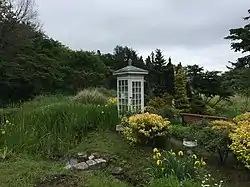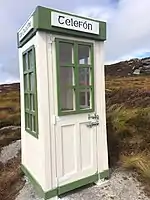| Wind phone | |
|---|---|
風の電話 | |
 Ōtsuchi wind phone in May 2018, before the inauguration of the newer aluminum booth | |
| General information | |
| Type | Telephone booth |
| Location | Ōtsuchi, Iwate Prefecture |
| Country | Japan |
| Coordinates | 39°23′10″N 141°55′55″E / 39.38611°N 141.93194°E |
The wind phone (風の電話, kaze no denwa) is an unconnected telephone booth in Ōtsuchi, Iwate Prefecture, Japan, where visitors can hold one-way conversations with deceased loved ones. Initially created by garden designer Itaru Sasaki in 2010 to help him cope with his cousin's death, it was opened to the public in the following year after the 2011 Tōhoku earthquake and tsunami killed over 15,000 people in the Tōhoku region. The wind phone has since received over 30,000 visitors. A number of replicas have been constructed around the world, and it has served as the inspiration for several novels and films.
Origin and description
In 2010, Itaru Sasaki, a garden designer from Ōtsuchi, learned that his cousin had terminal cancer with three months to live.[1] After his cousin's death, Sasaki set up an old telephone booth in his garden in December 2010, to continue to feel connected to him by "talking" to him on the phone.[1][2] According to Sasaki, the wind phone was not designed with any specific religious connotation, but rather as a way to reflect on his loss. In an interview, he stated: "Because my thoughts couldn't be relayed over a regular phone line, I wanted them to be carried on the wind."[3]
The wind phone is a white, glass-paned telephone booth containing a black, disconnected rotary dial telephone on a metal shelf.[1][3] A notebook is placed next to the telephone for messages of remembrance.[2] The booth is on a hill that overlooks Ōtsuchi.[4]
Public opening
.jpg.webp)
The 2011 Tōhoku tsunami resulted in the deaths of over 15,000 people in the Tōhoku region, including over 1,200 people in Ōtsuchi (about 10 percent of the town's population).[2][5] Sasaki subsequently opened the wind phone to the public to allow visitors to call their friends and family who had died in the disaster.[3] It has since been visited by over 30,000 people.[4]
On January 7, 2017, strong winds blew off the roof of the wind phone and broke the glass doors.[6] Local carpenters, including ones who had previously visited the wind phone, quickly volunteered to repair it on January[7] 10, and the wind phone was reopened by the next day.[8] In April 2018, Sasaki announced that the wooden and metal parts of the booth were deteriorating due to age and corrosion, even after a new coat of paint, and that he hoped to replace the old booth with a corrosion-resistant aluminum booth.[9] People responded with donations totaling about one million yen, and Sasaki installed the sturdier aluminum booth in August 2018.[10]
Replicas

Several replicas of the Ōtsuchi wind phone have been built around the world. In Oakland, California, local artist Jordan Stern constructed a wind telephone in February 2017, to commemorate the 36 people who died in the Ghost Ship warehouse fire, including his friend. According to Stern, the purpose of the wind phone was to comfort "a field of people grieving in Oakland".[11]
Altrúchas, an anonymous art collective based in Dublin, Ireland, set up a wind phone (fón gaoithe) atop Two Rock Mountain in August 2017.[12] The wind phone, which was constructed from salvaged materials, was installed without permission; at the time, Altrúchas stated that they planned on "maintaining it indefinitely".[13] It was destroyed for unknown reasons less than two weeks after it was set up.[14] In a statement, Altrúchas said that the destruction was "a strong statement from people that didn't like the project", but that they would not let it "take away from the positivity".[15]
Tomohiko and Kazuko Kutsuna, a married couple in Tahara, Aichi Prefecture, Japan, installed a red-painted replica in 2018. Their telephone booth, named the "phone of the sea breeze" (潮風の電話, shiokaze no denwa), was built in memory of one of Kazuko's students, an 18-year-old woman who died by suicide in 2009.[16]
Additional wind phones have been placed throughout the United States and Canada.[17][18][19][20]
In media
Literature
Sasaki, the creator of the Ōtsuchi wind phone, wrote a book of reflections titled Kaze no Denwa – Daishinsai Kara Rokunen, Kaze no Denwa o Tooshite Mieru Koto (風の電話:大震災から6年、風の電話を通して見えること, lit. 'The Phone of the Wind: What I Have Seen via the Phone in the Six Years Since the Earthquake') in 2017. The book was published by Kazama Shobo.[2]
The 2020 novel The Phone Box at the Edge of the World by Italian writer Laura Imai Messina tells the story of a woman who loses her family in the Tōhoku tsunami and travels to the wind phone, where she meets a widower and his daughter who have experienced similar losses. The novel was inspired by Messina's visit to the Ōtsuchi wind phone in 2011.[21]
The Phone Booth in Mr. Hirota's Garden, a 2020 novel by Canadian writer Heather Smith, is a fictionalized version of the wind phone's origins.[22] According to Smith, she was inspired by a National Public Radio podcast about the wind phone and exchanged emails with Sasaki during the writing process, stating that it "was a thrill to receive his blessing and an honour to share his beautiful approach to grief through this book."[23]
Film
The 2019 Austrian short film The Wind Phone, written and directed by Kristin Gerweck, follows seven fictional strangers who visit the Japanese wind phone.[24] Gerweck wrote the screenplay when she learned about the wind phone after her grandmother's death, saying: "I was intrigued by the emotional realities that could emerge in this metaphysical grieving space and so began my journey to translate this beautiful story to screen."[25]
Voices in the Wind (風の電話, Kaze no Denwa) is a 2020 Japanese drama film about a fictional high school student who lost her family in the Tōhoku tsunami and returns to her hometown to visit the wind phone years later.[26] Director Nobuhiro Suwa, who returned to Japan for filming, stated: "Going there eight years later, you can't see much of the damage, it has been rebuilt. But people's feelings have not been fixed."[4]
References
- 1 2 3 Fontaine, Tessa (July 25, 2018). "The Phone of the Wind". The Believer. Retrieved February 8, 2021.
- 1 2 3 4 Kono, Etsuo (August 18, 2017). "Japan's Otsuchi 'wind phone' lets the living talk to the dead". Australian Financial Review. Retrieved February 7, 2021.
- 1 2 3 Hester, Jessica Leigh (January 10, 2017). "The Phone Booth for Japanese Mourners". Bloomberg News. Retrieved February 7, 2021.
- 1 2 3 Blair, Gavin J (February 20, 2020). "Berlin Hidden Gem: 'Voices in the Wind' Depicts a Sense of Connection in Japan". The Hollywood Reporter. Retrieved February 7, 2021.
- ↑ "Police Countermeasures and Damage Situation associated with 2011 Tohoku district – off the Pacific Ocean Earthquake" (PDF). National Police Agency of Japan. Retrieved February 7, 2021.
- ↑ Yamaura, Masataka (January 8, 2015). "大槌町「風の電話ボックス」全壊 強風で飛ばされる". The Asahi Shimbun (in Japanese). Archived from the original on August 23, 2018. Retrieved February 8, 2021.
- ↑ Mcknight, Matt (2023-06-12). "'I need an outlet': Grieving relatives talk to lost loved ones on phone in the forest". Reuters. Retrieved 2023-06-18.
- ↑ Yamaura, Masataka (January 10, 2015). "倒壊した「風の電話ボックス」再建 全壊した扉作り直す". The Asahi Shimbun (in Japanese). Archived from the original on August 23, 2018. Retrieved February 8, 2021.
- ↑ Higashino, Masakazu (January 10, 2015). "'Hotline to heaven' needs new phone booth to help bereaved". The Asahi Shimbun. Archived from the original on April 12, 2018. Retrieved February 8, 2021.
- ↑ "「風の電話」アルミ製に交換 大槌、大切な人想う場所". Iwate Nippo. August 19, 2018. Archived from the original on August 23, 2018. Retrieved February 8, 2021.
- ↑ Garchik, Leah (March 19, 2017). "Wind telephone enables communication with Ghost Ship victims". San Francisco Chronicle. Retrieved February 7, 2021.
- ↑ Carty, Ed (August 16, 2017). "Gone with the wind: vandals destroy meditation space built on mountain". Irish Independent. Retrieved February 7, 2021.
- ↑ "'Wind Phone' intriguing passers-by in Dublin Mountains". RTÉ.ie. August 11, 2017. Retrieved February 7, 2021.
- ↑ "Wind Phone installation in Dublin Mountains destroyed". RTÉ.ie. August 15, 2017. Retrieved February 7, 2021.
- ↑ Aodha, Gráinne Ní (August 15, 2017). "The Wind Phone art project in the Dublin Mountains has been destroyed". TheJournal.ie. Retrieved February 7, 2021.
- ↑ Shimbun, Chunichi (September 24, 2018). "Aichi couple sets up phone booth for people seeking to connect with loved ones they have lost". The Japan Times. Retrieved February 7, 2021.
- ↑ Driscoll, Kathi Scrizzi (January 27, 2020). "Provincetown's Phone on the Wind allows the grieving to 'call' departed loved ones". The Standard-Times. Retrieved February 7, 2021.
- ↑ Hackett, Laura (December 17, 2020). "Marshall phone carves out space for spirituality and grief". Mountain Xpress. Retrieved February 7, 2021.
- ↑ "The Drop-In: Finding the Phone of the Winds on Aspen Mountain". The Aspen Times. March 8, 2021. Retrieved March 9, 2021.
- ↑ "How an unconnected telephone in a B.C. park is helping people mourn lost loved ones". CBC. October 28, 2021. Retrieved November 8, 2021.
- ↑ Spalding-Mulcock, Paul (July 2, 2020). "The Phone Box at the Edge of the World – Laura Imai Messina: A Finely Modulated Meditation Upon Grief". The Yorkshire Times. Retrieved February 8, 2021.
- ↑ "The Phone Booth in Mr. Hirota's Garden". Kirkus Reviews. June 15, 2019. Retrieved February 8, 2021.
- ↑ Ruurs, Margriet (October 1, 2020). "Can Write – Meet Heather Smith". Canadian Teacher Magazine. Retrieved February 8, 2021.
- ↑ "'The Wind Phone' Included in L.A. Shorts International Film Festival". Rafu Shimpo. July 24, 2019. Retrieved February 7, 2021.
- ↑ Culross, Mikey Hirano (August 15, 2019). "'The Wind Phone' Screens Sunday at JFFLA". Rafu Shimpo. Retrieved February 7, 2021.
- ↑ Hadfield, James (January 23, 2020). "'Voices in the Wind': Loss and a haunting journey home". The Japan Times. Retrieved February 7, 2021.